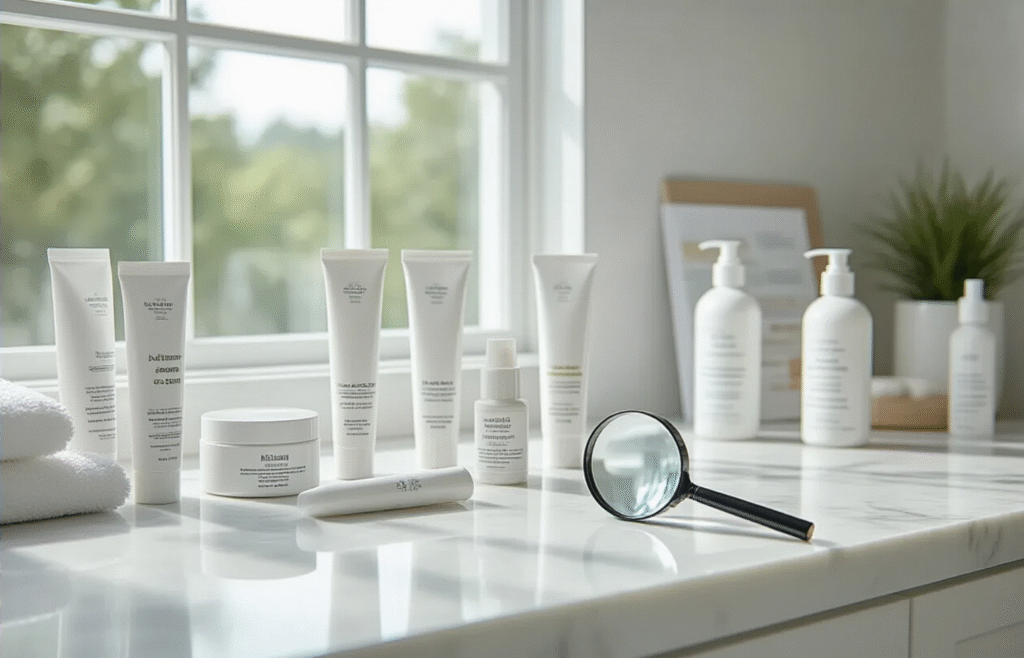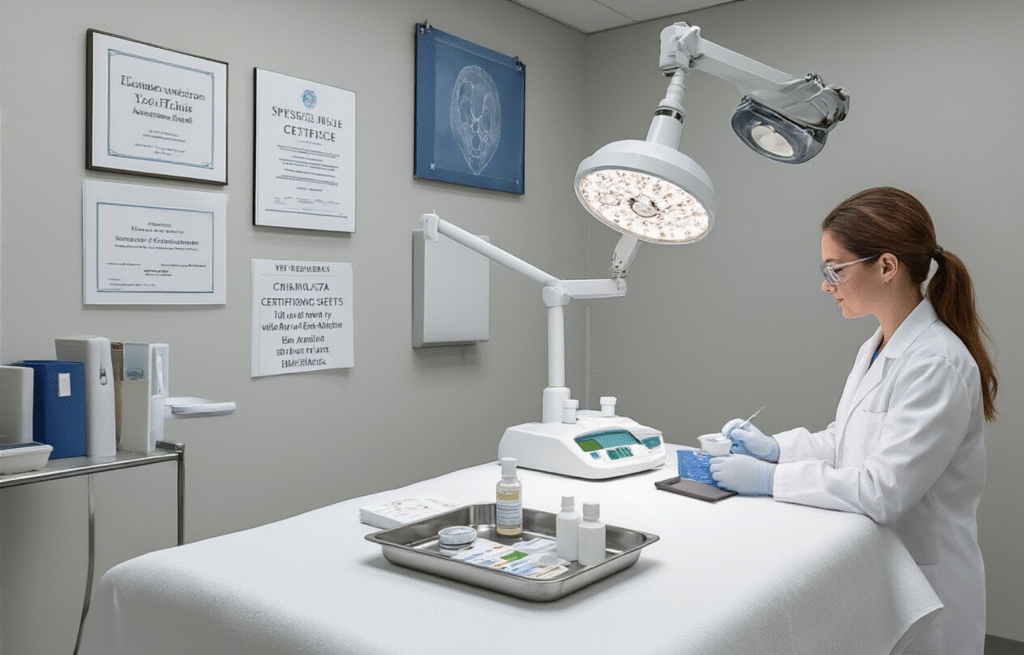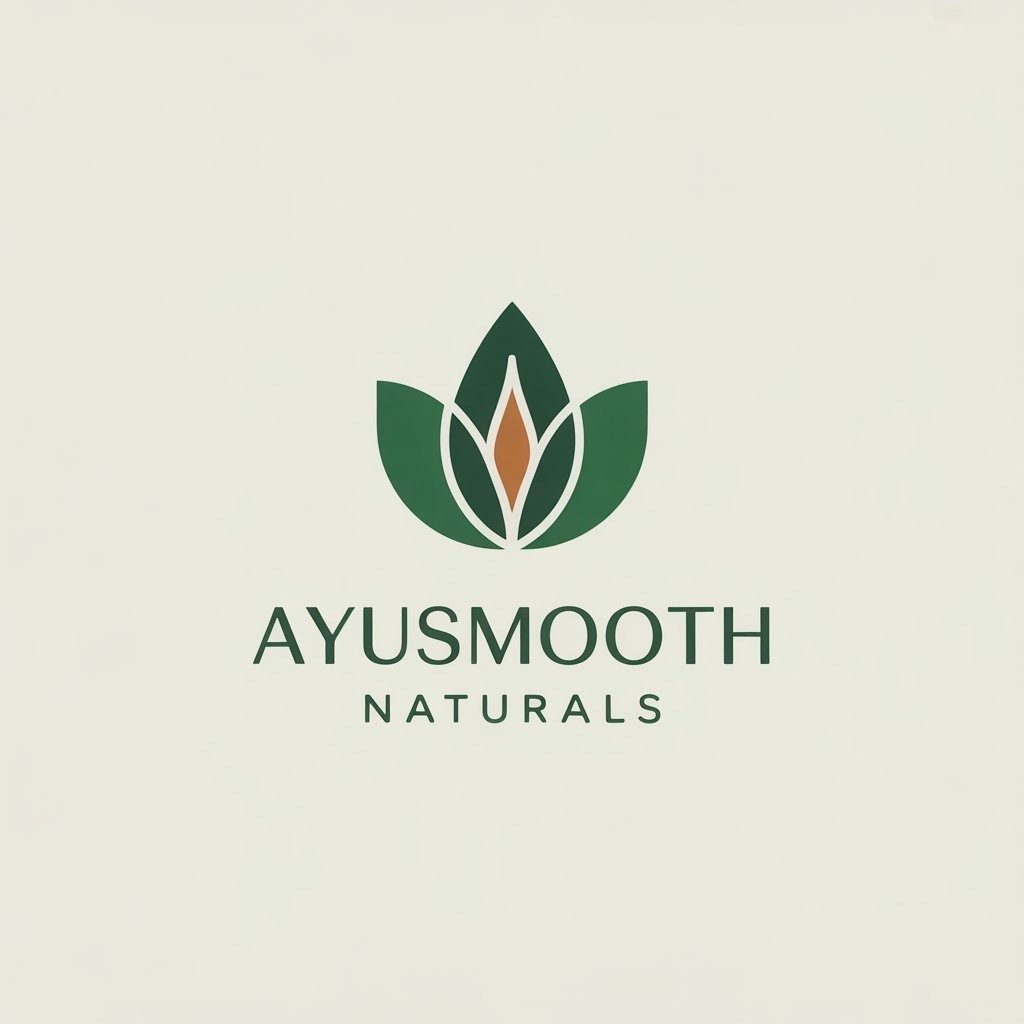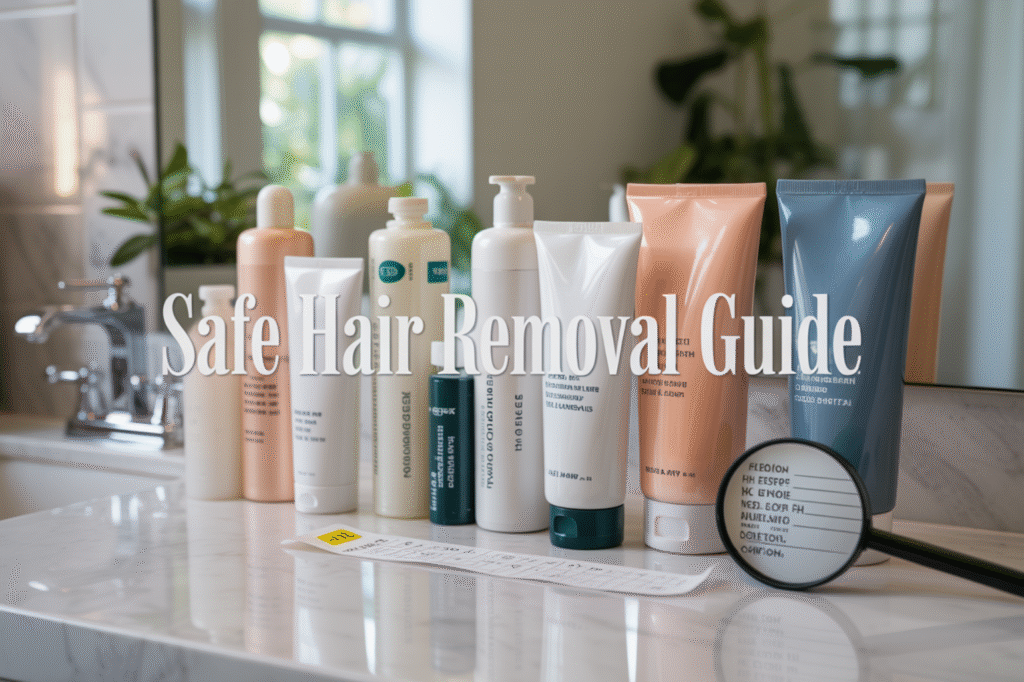Ingredients, pH, and Clinical Criteria
Hair removal creams offer a convenient at-home solution, but choosing the wrong product can lead to
burns, irritation, or allergic reactions. This guide is for anyone who wants to safely remove unwanted hair
without damaging their skin, especially those with sensitive skin or previous bad experiences with
depilatory products.
We’ll walk you through the key ingredients that can harm your skin and which ones actually protect it
during the hair removal process. You’ll also learn about pH balance requirements that make the
difference between effective hair removal and chemical burns, plus the clinical safety standards that
separate quality products from potentially dangerous ones.
By the end, you’ll know exactly what to look for on product labels and how to select a hair removal cream
that works effectively while keeping your skin healthy and irritation-free.
Understanding Hair Removal Cream SafetyFundamentals
Identify Your Skin Type and Sensitivity Level
Before reaching for any hair removal cream, you need to figure out what type of skin you’re working with.
Your skin’s characteristics directly impact how it will react to chemical depilatories, and getting this wrong
can lead to painful burns, rashes, or long-lasting irritation.
Start with the basic skin types: normal, dry, oily, combination, or sensitive. Sensitive skin requires extra
caution since it reacts more strongly to chemical ingredients. If you regularly experience redness,
stinging, or breakouts from skincare products, you likely have sensitive skin.
Pay attention to how your skin behaves in different areas of your body. The skin on your legs might
tolerate stronger formulations, while your bikini area or underarms need gentler options. Facial skin is
typically the most delicate and requires specialized formulations with lower chemical concentrations.
Test your sensitivity level by applying a small amount of the cream to your inner wrist or behind your ear.
Wait 24-48 hours and watch for any redness, swelling, itching, or burning. This patch test isn’t
optional—it’s your first line of defense against adverse reactions.
Consider your medical history too. Recent sun exposure, active skin conditions like eczema or
dermatitis, or current use of retinoids or exfoliating acids can increase your skin’s sensitivity to hair
removal chemicals.Recognize Common Allergic Reactions and Warning Signs
Hair removal creams can trigger various reactions, from mild irritation to severe chemical burns. Knowing
what to watch for helps you stop using the product before serious damage occurs.
Immediate warning signs include burning, stinging, or tingling sensations that feel more intense than the
mild tingling described in product instructions. Your skin shouldn’t feel like it’s on fire—that’s your cue to
rinse off the cream immediately.
Visual symptoms to monitor include:
Redness that spreads beyond the application area
Swelling or puffiness around treated areas
Blistering or raised bumps that appear during or after treatment
White or discolored patches indicating chemical burns
Persistent itching that continues hours after removal
Delayed reactions can appear 12-72 hours after use. These might include persistent redness, peeling
skin, or darkening of treated areas (hyperpigmentation). Some people develop contact dermatitis, which
creates a rash-like pattern matching where the cream was applied.
Severe allergic reactions, though rare, can include difficulty breathing, widespread hives, or facial
swelling. These require immediate medical attention.
Keep detailed records of any reactions, including the specific product used, application time, and
symptoms experienced. This information helps you identify problematic ingredients and guides future
product selections.
Understand FDA Regulations and Safety Standards
The FDA classifies hair removal creams as cosmetics, not drugs, which means they face less stringent
testing requirements than medications. This classification puts more responsibility on you to research
and choose products carefully.
Under current regulations, manufacturers must ensure their products are safe for intended use, but they
don’t need FDA approval before hitting store shelves. The FDA only steps in after receiving reports of
adverse reactions or safety concerns.Key regulatory requirements include:
Ingredient labeling must list all components in descending order of concentration
Warning labels must include patch test instructions and safety precautions
Contact information for reporting adverse reactions must be provided
Claims substantiation requires some evidence, though testing standards aren’t specified
Look for products that exceed minimum requirements. Some manufacturers conduct clinical testing,
dermatologist evaluations, or third-party safety assessments. While not required, these extra steps often
indicate higher quality control standards.
The FDA maintains a database of adverse event reports through their CAERS system. You can search
this database to see if specific products or ingredients have generated safety concerns.
International standards sometimes offer additional guidance. European regulations tend to be stricter,
and products meeting EU safety standards often provide extra assurance of safety and efficacy.
Report any adverse reactions to both the manufacturer and the FDA through their MedWatch system.
Your reports help identify safety patterns and can lead to improved regulations or product recalls when
necessary.

Key Ingredients to Avoid for Safer Hair RemovalHarmful Chemicals That Cause Skin Irritation
Sodium hydroxide and potassium hydroxide top the list of ingredients that can wreak havoc on your skin.
These alkaline chemicals work by breaking down hair structure but can easily cause chemical burns if
the concentration is too high or left on skin too long. Look for products containing these compounds in
concentrations below 2% for facial use and 5% for body application.
Calcium thioglycolate presents another red flag. While effective at dissolving hair, this sulfur compound
frequently triggers contact dermatitis, leaving skin red, swollen, and painful. People with sensitive skin
should avoid this ingredient entirely, as even patch testing may result in lasting sensitivity.
Ammonia-based compounds create an overly alkaline environment that strips away your skin’s natural
protective barrier. This disruption leads to dryness, flaking, and increased susceptibility to bacterial
infections. Ammonium hydroxide specifically can cause respiratory irritation when inhaled during
application.
Fragrances and Preservatives That Trigger Allergies
Synthetic fragrances mask the natural chemical odor of hair removal creams but come with serious
drawbacks. Phthalates used in fragrance formulations act as endocrine disruptors and commonly cause
allergic reactions. The term “parfum” or “fragrance” on ingredient lists hides dozens of potential allergens
that manufacturers aren’t required to disclose individually.
Parabens serve as preservatives but mimic estrogen in your body and frequently cause skinsensitization. Methylparaben, propylparaben, and butylparaben accumulate in tissue over time and may
contribute to hormonal imbalances. Even “paraben-free” products often substitute equally problematic
preservatives like methylisothiazolinone.
Formaldehyde-releasing preservatives such as DMDM hydantoin and imidazolidinyl urea slowly release
formaldehyde gas, which causes both skin irritation and respiratory problems. These chemicals remain
active long after application, creating ongoing exposure risks.
Heavy Metals and Toxic Compounds to Watch For
Lead, mercury, and cadmium contamination occurs more frequently than consumers realize, especially
in imported products lacking proper quality control. These heavy metals accumulate in your body over
time and can cause neurological damage, kidney problems, and reproductive issues. Always choose
products from reputable manufacturers who conduct third-party testing for heavy metal contamination.
Hydroquinone appears in some hair removal creams marketed for darker skin tones but carries serious
health risks. This skin-lightening agent can cause permanent skin discoloration, liver damage, and has
been linked to cancer in animal studies. Many countries have banned hydroquinone in cosmetic products
due to these safety concerns.
Chromium compounds used in some formulations can cause severe allergic reactions and skin
ulceration. Even small amounts can trigger lifelong chromium sensitivity, making future exposure
extremely dangerous.
Natural Alternatives That Still Pose Risks
Don’t assume natural ingredients are automatically safe. Essential oils like tea tree, eucalyptus, and
citrus oils frequently cause allergic reactions and photosensitivity. These concentrated plant extracts can
be more irritating than synthetic alternatives, especially on freshly treated skin where the protective
barrier is compromised.
Papaya and pineapple enzymes sound gentle but contain powerful proteolytic enzymes that can cause
severe burns on sensitive areas. These fruit acids work by digesting proteins, which includes your skin if
left on too long or used in high concentrations.
Turmeric, while praised for its anti-inflammatory properties, can cause permanent yellow staining and
photosensitive reactions. The curcumin compound becomes more reactive when exposed to sunlight,
potentially leading to painful burns and lasting hyperpigmentation.
Even seemingly innocent ingredients like coconut oil can clog pores and trap irritating chemicals against
your skin, intensifying adverse reactions to other formula components.Essential Safe Ingredients That Protect Your Skin
Moisturizing Agents That Prevent Dryness
Hair removal creams can strip away natural oils from your skin, leaving it dry and vulnerable. Look for
products containing glycerin, hyaluronic acid, and ceramides – these powerhouse ingredients work
overtime to keep your skin hydrated throughout the hair removal process.
Glycerin acts like a magnet for moisture, pulling water from the environment directly into your skin cells.
You’ll find this ingredient listed near the top of quality formulations because it’s both effective and gentle.
Hyaluronic acid holds up to 1,000 times its weight in water, creating a protective moisture barrier that
lasts hours after application.
Ceramides deserve special attention because they actually repair your skin’s natural barrier function.
These lipid molecules fill in the gaps between skin cells, preventing water loss and blocking irritants from
penetrating deeper layers. Natural oils like jojoba, argan, and squalane also provide excellent
moisturizing benefits without clogging pores.
Anti-Inflammatory Compounds That Soothe Skin
The chemical process of hair dissolution naturally triggers some inflammatory response in your skin.
Smart formulations include ingredients that actively calm this reaction before it becomes problematic.Aloe vera gel contains over 75 active compounds that reduce redness and swelling on contact. Look for
products listing aloe barbadensis leaf extract high on their ingredient list – this means you’re getting a
therapeutic concentration rather than just a marketing add-on.
Chamomile extract (specifically bisabolol) provides gentle anti-inflammatory action that’s been used
medicinally for centuries. Centella asiatica, also known as cica or tiger grass, accelerates skin repair
while reducing sensitivity. This Korean skincare favorite has gained popularity for good reason – it
actually strengthens your skin’s resilience over time.
Niacinamide (vitamin B3) works differently by regulating your skin’s inflammatory pathways at the cellular
level. Products containing 2-5% niacinamide help minimize irritation while improving overall skin texture
and barrier function.
Antioxidants That Repair and Protect

Chemical hair removal creates free radicals that can damage skin cells and accelerate aging. Antioxidant
ingredients neutralize these harmful molecules while supporting your skin’s natural repair processes.
Vitamin E (tocopherol) acts as your first line of defense, intercepting free radicals before they can cause
cellular damage. When combined with vitamin C (ascorbic acid or magnesium ascorbyl phosphate),
these vitamins work synergistically to provide enhanced protection.
Green tea extract contains powerful polyphenols, particularly EGCG, that offer both antioxidant and anti-
inflammatory benefits. These compounds help prevent the breakdown of collagen and elastin fibers that
keep your skin firm and smooth.
Resveratrol, derived from grape skin, provides exceptional antioxidant protection while stimulating
cellular renewal. Look for products that combine multiple antioxidants rather than relying on just one –
your skin benefits from this diverse protective network.
pH Balancing Ingredients for Optimal Skin Health
Your skin’s natural pH hovers around 5.5, creating an acidic environment that protects against harmful
bacteria and maintains proper barrier function. Hair removal creams often disrupt this balance, making
pH-correcting ingredients essential.
Lactic acid and citric acid serve dual purposes – they help maintain optimal pH levels while providing
gentle exfoliation that prevents ingrown hairs. These alpha hydroxy acids work at low concentrations to
support skin health without causing irritation.
Sodium lactate and sodium PCA are naturally occurring compounds that regulate pH while boosting
hydration. Your skin actually produces these substances on its own, so adding them topically supports
your natural protective mechanisms.
Panthenol (pro-vitamin B5) helps stabilize pH levels while promoting skin healing and regeneration. Thismultitasking ingredient converts to pantothenic acid in your skin, supporting cellular metabolism and
barrier repair functions that keep your skin healthy long after hair removal.
pH Balance Requirements for Effective Hair
Removal
Ideal pH Range for Safe Depilatory Products
Hair removal creams work best within a specific pH range of 11.5 to 13.0, which is highly alkaline. This
alkalinity breaks down the keratin proteins in hair shafts, dissolving them at the surface level. Products
below pH 11 won’t effectively dissolve hair, while those above pH 13 pose serious chemical burn risks.
Quality manufacturers carefully formulate their products to maintain this optimal range while
incorporating buffering agents that prevent pH spikes during storage. Look for products that clearly state
their pH levels on packaging or provide this information through customer service channels.
The timing factor becomes critical within this pH range. Products at the lower end (pH 11.5-12) require
longer contact times but offer gentler action, making them suitable for sensitive areas. Higher pH
formulations (pH 12.5-13) work faster but demand strict adherence to recommended application times.How pH Affects Skin Barrier Function
Your skin’s natural pH sits around 4.5 to 5.5, creating an acidic mantle that protects against harmful
bacteria and environmental damage. When hair removal creams introduce highly alkaline conditions,
they temporarily disrupt this protective barrier.
The alkaline environment swells skin cells and increases permeability, allowing the active ingredients to
penetrate and reach hair follicles. However, this same process makes skin more vulnerable to irritation,
moisture loss, and potential allergic reactions.
Prolonged exposure to high pH levels can lead to:
Contact dermatitis from excessive alkalinity
Compromised moisture retention as the skin barrier weakens
Increased sensitivity to other skincare products
Delayed healing if minor abrasions occur during hair removal
Your skin typically restores its natural pH balance within 2-6 hours after product removal, but repeated
use without proper recovery time can cause cumulative damage. This explains why most manufacturers
recommend waiting 72 hours between applications.
Testing pH Levels at Home Before Use
Digital pH meters provide the most accurate readings, but pH test strips offer a practical alternative for
home testing. Purchase strips with a range covering pH 10-14 for hair removal products.
Simple Testing Method:
1.
Squeeze a small amount of cream onto a clean spoon
2.
Dip the pH strip into the product for 2-3 seconds
3.
Compare the color change to the provided chart
4.
Record the reading and date for future reference
Test products immediately after opening and again after 30 days of storage. Temperature fluctuationsand exposure to air can alter pH levels over time. Store opened products in cool, dry locations to
maintain stability.
Warning Signs to Watch For:
pH readings above 13.0 indicate potential burn risk
Readings below 11.0 suggest reduced effectiveness
Inconsistent readings between tests signal product degradation
Create a simple log tracking pH levels, storage conditions, and any skin reactions. This data helps
identify patterns and ensures you’re using products within safe parameters. Replace any product
showing significant pH drift or unusual color changes in the formula itself.
Clinical Safety Criteria and Professional Standards
Dermatologist-Tested Certifications to Look For
When shopping for hair removal creams, you’ll see “dermatologist-tested” labels everywhere. But not allcertifications carry the same weight. Look for specific certifications from recognized organizations like the
American Academy of Dermatology or the International Association of Dermatologists.
The most reliable certifications include detailed study information, showing how many participants were
tested and over what time period. Products tested on at least 100 people for 21 days or longer provide
more meaningful data than quick patch tests on small groups.
Some brands go further with specialized certifications for sensitive skin conditions. If you have eczema,
rosacea, or other skin concerns, seek products certified by relevant medical associations. These
undergo additional testing protocols specifically designed for compromised skin barriers.
Clinical Study Requirements and What They Mean
Real clinical studies follow strict protocols that separate legitimate products from marketing hype. Proper
studies include control groups, standardized application methods, and objective measurements of skin
irritation using tools like trans-epidermal water loss meters and pH measurements.
Study Component What to Look For Red Flags
Sample Size 50+ participants Under 20 people
Duration 4+ weeks Single application tests
Methodology Double-blind, controlled Vague “user satisfaction” surveys
Measurements Objective skin metrics Only subjective feedback
Reputable studies publish their methodology and results in peer-reviewed journals. Companies that
reference specific study numbers or provide detailed protocols demonstrate transparency. Be wary of
brands that only mention “clinical testing” without specifics.
Hypoallergenic Claims and Their Validity
The term “hypoallergenic” isn’t regulated by the FDA, making it essentially meaningless without
supporting evidence. Any company can slap this label on their product without proving reduced allergic
reactions.
Valid hypoallergenic claims come with documentation showing reduced allergic responses in patch
testing compared to standard formulations. Look for products that specify which common allergens
they’ve removed, such as fragrances, parabens, or specific botanical extracts.
Some manufacturers conduct Human Repeat Insult Patch Tests (HRIPT) – the gold standard for allergy
testing. These studies expose participants to the product repeatedly over several weeks, then challenge
the skin after a rest period to detect delayed allergic reactions.
Third-Party Safety Testing and Verification
Independent testing labs provide unbiased safety verification that’s far more trustworthy than in-house
company testing. Reputable third-party organizations include SGS, Intertek, and Bureau Veritas, which
maintain strict testing protocols and have no financial incentive to pass unsafe products.These labs test for skin irritation potential using standardized methods like the Draize test or newer
alternatives like artificial skin models. They also verify pH levels, microbial safety, and ingredient purity.
Look for specific certifications like ISO 10993 for biological evaluation of medical devices, which some
premium hair removal products pursue voluntarily. Products meeting pharmaceutical-grade
manufacturing standards (GMP certification) demonstrate commitment to safety and quality control
throughout production.
The best brands publish their third-party test results and lab certificates on their websites or make them
available upon request. This transparency shows confidence in their product’s safety profile and allows
consumers to make informed decisions based on scientific data rather than marketing claims.
Practical Selection Process for Your Perfect Product
Reading Labels Like a Safety Expert
Learning to decode ingredient lists transforms you from a casual shopper into an informed consumer.
Start by scanning for the active ingredients first—these are your hair-dissolving agents like calcium
thioglycolate or potassium thioglycolate. Check their concentration levels, which should typically stay
below 7% for at-home use.
Next, hunt for the pH indicators or buffering agents. Look for sodium hydroxide, calcium hydroxide, or
guanidine carbonate listed among the first five ingredients. These control the cream’s alkalinity anddirectly impact your skin’s safety.
Red flag ingredients deserve special attention. Avoid products containing formaldehyde, parabens
ending in -paraben, sulfates like sodium lauryl sulfate, and artificial fragrances listed simply as
“fragrance” or “parfum.” These can cause irritation, allergic reactions, or long-term skin damage.
Pay attention to protective ingredients that signal quality formulation. Aloe vera, chamomile extract,
vitamin E, glycerin, and natural oils like coconut or jojoba indicate the manufacturer prioritized skin health
alongside hair removal effectiveness.
The ingredient order matters tremendously. Components listed first make up the highest concentrations,
while those at the end comprise less than 1% of the formula. If harsh chemicals appear early in the list
while soothing agents sit at the bottom, consider alternative products.
Patch Testing Techniques That Actually Work
Proper patch testing can save you from painful chemical burns and lasting skin damage. Choose an
inconspicuous area like the inner wrist, behind the ear, or inside the elbow crease. Clean the test area
thoroughly with mild soap and pat dry completely.
Apply a small amount of cream—about the size of a dime—and spread it evenly across a quarter-sized
area. Don’t rub it in aggressively; gentle application mimics real-world usage better than vigorous
rubbing.
Wait exactly the time specified on the package instructions, typically 3-10 minutes. Set a timer because
guessing leads to overexposure. Remove the cream with a damp cloth, wiping gently in one direction
rather than scrubbing back and forth.
Monitor the test area for 24-48 hours after removal. Normal reactions include slight pinkness that fades
within an hour. Warning signs include persistent redness, swelling, burning sensations, blistering, or
itching that worsens over time.
Test multiple areas if you have sensitive skin or a history of reactions. Try the inner arm, behind the
knee, and a small spot near your intended treatment area. Different body regions have varying sensitivity
levels, so comprehensive testing provides better safety data.
Document your results with photos and notes. Record the exact product name, application time, removal
method, and any reactions observed. This information becomes invaluable for future product selection
and helps identify patterns in your skin’s responses.
Brand Research and Reputation Assessment
Investigating brand credibility requires digging deeper than marketing claims and celebrity
endorsements. Start with the company’s manufacturing standards and certifications. Look for FDA
registration, Good Manufacturing Practice (GMP) compliance, and third-party testing certificationsdisplayed prominently on their website.
Check dermatologist recommendations and clinical study citations. Reputable brands invest in
professional testing and publish results through peer-reviewed research or dermatological partnerships.
Be wary of vague claims like “clinically tested” without specific study details or “dermatologist approved”
without named professionals.
Customer reviews reveal real-world performance, but read them strategically. Focus on reviews
mentioning specific skin types, application methods, and detailed results rather than simple star ratings.
Look for patterns in negative reviews—consistent complaints about burns, ineffectiveness, or strong
odors indicate potential problems.
Professional beauty supply stores often carry higher-quality brands than general retail chains. Staff at
these locations typically receive product training and can provide insights about brand reputations within
the industry. Salon professionals frequently test multiple products and share honest feedback about
performance and safety.
Research the brand’s history and recall records through FDA databases and consumer protection
websites. Companies with multiple product recalls or unresolved safety complaints present higher risks.
Established brands with decades of safe operation generally maintain stricter quality control than newer
market entrants.
Consider the brand’s customer service responsiveness and return policies. Companies confident in their
product safety typically offer generous return windows and responsive customer support for addressing
concerns or adverse reactions.Finding the right hair removal cream doesn’t have to be overwhelming when you know what to look for.
The key is focusing on three main areas: avoiding harsh ingredients like thioglycolates and strong
fragrances, choosing products with skin-protecting ingredients like aloe vera and vitamin E, and making
sure the pH stays between 10-12.5 for safe and effective results. Professional standards and clinical
testing give you that extra confidence that the product won’t cause unexpected reactions.
Start your selection process by reading ingredient labels carefully and doing a patch test on a small area
first. Your skin will thank you for taking these simple steps. Remember, the cheapest option isn’t always
the safest, and spending a bit more on a quality product with proven ingredients can save you from
painful burns or irritation. Take your time, do your research, and choose a cream that meets both your
hair removal needs and your skin’s safety requirements.

